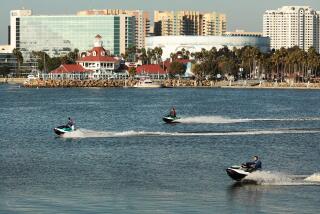In Balboa Park, People’s Needs Should Outweigh Another Museum
- Share via
The controversy over the proper use of Balboa Park has been going on for years, and the most recent months have been no exception. The future use of the old Navy hospital buildings and the latest version of the Pekarek master plan are good examples. But the hottest issue of 1986 has been the attempt to remove the Special Olympics activities, the square dancers and cloggers, the Ping Pong Club and the numerous other users from the Conference Building to fit another museum into the park.
An authentic auto museum could be a positive addition to San Diego--but not if it means kicking citizens out of the park. The museum backers have said the building is barely used, but the facts are that it is used almost every day and every evening of the entire year.
The Ping Pong Club uses it Monday through Friday year-round. The Special Olympics shares evening use with the table tennis players three nights per week from September through January and throughout the month of May. A Special Olympics Floor Hockey Tournament of international scope is held annually and involves more than 65 teams from California, numerous other states and Canada.
The cloggers and square dancers use the building 20 or more Saturday evenings and every Sunday evening. And numerous other civic uses occur continually throughout the year.
The Park and Recreation Department and Disabled Services staff offices have been in the building for years.
Despite this officially documented full-time use, the car museum leaders continue to say the building is “empty” and have coined the term “ghost building” to try to persuade the public to support the museum.
The city’s interest in the museum was originally financial because it said it could not afford to repair and maintain the park buildings. The Square Dance Assn. came forward and promised to pay the estimated $34,000-a-year maintenance and utility expenses plus the cost of renovating the building. In fact, the association has already collected more than $50,000 to pay for complete renovation and received a firm bid of $43,000 to do all the necessary exterior work.
In other words, the city can continue to allow all current activity to remain in the Conference Building, and the city’s financial obligation will be eliminated. (According to Balboa Park staffers, the building is structurally sound and requires no other work if existing uses are allowed to continue.)
On the other hand, the museum supporters want a free 25-year lease on the building; $82,000 a year in tax support from the city, and removal of the city offices housed there.
Because the city has inadequate office space available to relocate these offices, the added cost to the city for leasing alternative space could be more than $70,000 per year. The bottom line to the city is that a museum will cost at least $152,000 a year, less the annual $34,000 maintenance costs that the museum has agreed to pay.
The arithmetic is simple: the city saves money by keeping the Conference Building for the handicapped, dancers and other public users but will lose at least $118,000 a year if a museum moves in.
The Square Dance Assn., the Special Olympics organization and all the other current users of the building have come forward to try to maintain a balance within the park of museums, recreational activities, open park areas and cultural/civic functions. There are already a dozen museums within the park, forcing overcrowding and parking problems--especially on weekends. Conference Building users are primarily evening users (except for city offices), thus helping balance park activities between day and evening events.
The current users, led by the Square Dance Assn., have united in a show of good citizenship and support for park needs by providing significant, immediate and long-term financial support. They ask for no tax support, as the museum does. They don’t ask for a “free” building, as the museum does. They don’t demand that city offices be moved to expensive leased facilities, as the museum would require. They simply want San Diego’s favorite park to remain available to all citizens and believe that, as San Diego continues to grow, such facilities will be in even more demand. They don’t want to restrict the building’s use to a select group, but want any and all public/civic uses to be continued in the building, as they have since 1948.
The City Council will finally vote on this issue Monday. We firmly believe that all the financial and philosophical arguments support the current users. Therefore, the council should reject the car museum and maintain the unique and wonderful balance that has benefited the public for so many years.
More to Read
The biggest entertainment stories
Get our big stories about Hollywood, film, television, music, arts, culture and more right in your inbox as soon as they publish.
You may occasionally receive promotional content from the Los Angeles Times.










